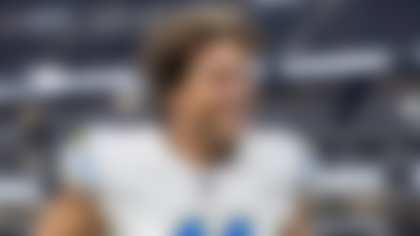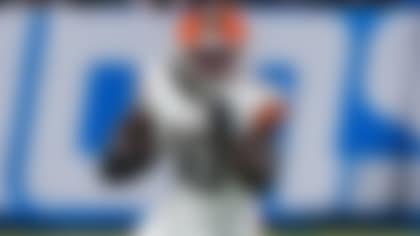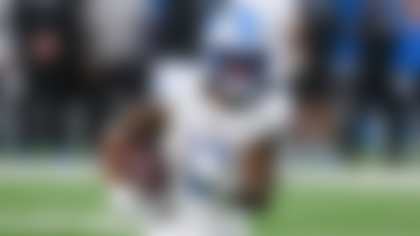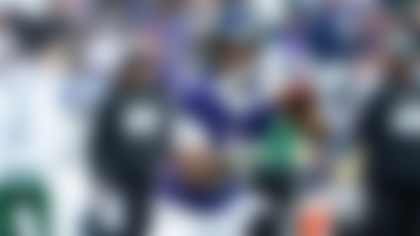If you've played fantasy football for any length of time, you know it's a game filled with acronyms. PPR, ADP, FAAB, IDP ... record scratch.
Wait, what?! You don't know IDP? Have a seat, my friend, we're about to do some learnin'.
Let's start with the basics. IDP stands for Individual Defensive Player. It's just what it sounds like. It's a fantasy league that usually dispenses of the D/ST (Defense/Special teams) spot in place of -- you guessed it -- individual defensive players.
Like all other fantasy formats, roster sizes and configurations can vary across leagues. Most beginner leagues include as few as three spots. More advanced leagues can add up to 11 IDP slots. The more defensive slots your league showcases, the higher the difficulty level. But it also opens a lot more strategy options.
Generally, IDP leagues feature three positions -- defensive line (DL), linebacker (LB) and defensive back (DB). You can get more granular within those three designations, if you choose. Some leagues break up the DL category into defensive end (DE) and defensive tackle (DT). Linebackers can be broken up into middle linebacker (MLB) and outside linebacker (OLB). And defensive backs can split into cornerback (CB) and safety (S). But for now, let's keep it simple.
Then there's the scoring. Just like offensive players, IDPs can score in a variety of ways. The most common categories are tackles, tackles for loss, sacks, QB hits, passes defensed, interceptions, forced fumbles, fumble recoveries and defensive touchdowns. If you want to get fancy, you can include things like return yards for defensive plays or points for blocked kicks and punts.
So, when should you start making the move for IDP players? How should you attack each position? And who exactly should you target? Let's dig deeper into your options ...
DRAFT STRATEGY
The point at which fantasy managers pivot to drafting defensive players will depend heavily on how many defensive players you need to roster. Simply put, the fewer players you need to start, the later you can wait to draft them. If you only need three guys, the waiver wire will be deep. Conversely, if you need to start 11 players, there won't be much in the free-agent pool. It's more important to build a solid roster through the draft.
Nonetheless, it's best to focus on offense for the first six or seven rounds before thinking about the defensive side. Like drafting quarterbacks, you don't need to be the first person to take one. But once the run starts, you don't want to wait too long to get on board. From there, you can sprinkle in defensive players with offensive players as you fill out the rest of your team.
POSITIONAL STRATEGY
1) Defensive line: This is the shallowest position in the IDP draft pool. Much like with offensive players in fantasy, snap counts can go a long way toward quality production. However, because NFL teams tend to rotate heavily along the defensive line, it's hard to find consistency. Specialization in defensive schemes makes it hard to find high-ceiling options. Think of it as the defensive equivalent of fantasy tight ends. Much like you wouldn't draft a primarily run-blocking tight end, you don't want a space-eating nose tackle who doesn't fill up the stat sheet.
Because many IDP scoring systems prioritize sacks and tackles, this is the position that many managers will attack first. There is a definite top tier of stud edge rushers, who collect plenty of sacks and tackles. Guys like T.J. Watt, Myles Garrett and new Packers acquisition Micah Parsons are going to come off the board quickly.
PLAYERS TO TARGET
- Tier 1: T.J. Watt, Pittsburgh Steelers; Myles Garrett, Cleveland Browns; Trey Hendrickson, Cincinnati Bengals; Aidan Hutchinson, Detroit Lions; Micah Parsons, Green Bay Packers
- Tier 2: Maxx Crosby, Las Vegas Raiders; Nick Bosa, San Francisco 49ers; Will Anderson Jr., Houston Texans.
- Tier 3: Andrew Van Ginkel, Minnesota Vikings; Jonathan Greenard, Minnesota Vikings; Greg Rousseau, Buffalo Bills.
2) Linebackers: Linebacker is where you'll accumulate most of your fantasy production, and it's where you can load up on players with high tackle numbers. The best ones will also notch sacks and turnovers. The good news is that linebacker is the deepest position in the IDP draft pool, so you don't necessarily need to reach to find a good one. However, it does mean that when the run starts, you'll need to move quickly. Think of it as the defensive equivalent of wide receiver.
A word of caution: You'll run into plenty of players who have a dual designation of DL/LB. While it might be tempting to take T.J. Watt or Micah Parsons and put him in your linebacker spot, it's not always the best idea. Because there is so much more depth at LB than at DL, you're better off taking your dual-designation players and starting them on the defensive line. That way you won't have to draft extra players or constantly comb the waiver wire to fill your DL spots.
PLAYERS TO TARGET
- Tier 1: T.J. Watt, Pittsburgh Steelers; Micah Parsons, Green Bay Packers.
- Tier 2: Zack Baun, Philadelphia Eagles; Roquan Smith, Baltimore Ravens; Zaire Franklin, Indianapolis Colts; Fred Warner, San Francisco 49ers.
- Tier 3: Robert Spillane, New England Patriots; T.J. Edwards, Chicago Bears; Frankie Luvu, Washington Commanders.
3) Defensive backs: The first time I played in an IDP league, my instinct was to seek out the top corners in the league. At that time, Darrelle Revis was marooning receivers on his island while Richard Sherman and his mates were bringing the Boom in Seattle. What I quickly learned was that shutdown corners make for poor IDP options. The reason is simple. Teams don't throw their way very often. They'll get interceptions when given opportunities, but their tackle numbers might be lower than what you'd hope to see. The biggest values will be at safety, where players can roam more freely and be big-time playmakers.
Regardless, there are plenty of options at the position -- both in the draft and on the waiver wire. Defensive backs tend to be the ficklest position year over year. Teams cycle through corners and rotate safeties. It's not uncommon for guys to be up one year and down the next. It's likely you'll cycle through several players at that spot as well.
PLAYERS TO TARGET
- Tier 1: Brian Branch, Detroit Lions; Budda Baker, Arizona Cardinals; Kyle Hamilton, Baltimore Ravens; Derwin James, Los Angeles Chargers.
- Tier 2: Jessie Bates, Atlanta Falcons; Antoine Winfield Jr., Tampa Bay Buccaneers; Julian Love, Seattle Seahawks; Xavier McKinney, Green Bay Packers.
- Tier 3: Tyler Nubin, New York Giants; Kerby Joseph, Detroit Lions; Kyle Dugger, New England Patriots; Nick Cross, Indianapolis Colts.
THE TRAVIS HUNTER FACTOR
There's one more thing worth touching on. It's the NFL's newest unicorn -- Travis Hunter. The expectation is for the Jaguars to use Hunter primarily on offense. But the team has not shied away from acknowledging the rookie will have a role on defense as well. That presents an interesting conundrum. How will he be handled in fantasy leagues?
It might sound like a cop-out, but this is one that you will need to discuss with your commissioner and league mates. Will Hunter get both offensive and defensive points regardless of where you place him in your lineup? Will he only accumulate points at the position where he's placed? This will go a long way toward determining his draft value in your leagues. There's no easy or correct answer. But it's one you'll need to be absolutely clear on come draft day.
There you have it. Welcome to a new fantasy football challenge. Don't worry, you're going to make mistakes. That's part of the fun. Study up, dive in and enjoy a new way to play fantasy football. Good luck!
Marcas Grant is a fantasy analyst for NFL.com and a man who encourages you to try new things. Send him your random adventures or fantasy football questions on Bluesky @marcasg.bsky.social or TikTok at marcasgrant.












